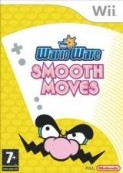Review: Wario Ware: Smooth Moves
Posted 09 Feb 2007 at 13:59 by Mark Cullinane
Wii Review

| "This is a wondrous exhibition of what the new controller can do in the right hands." |
Being a game designer at Nintendo must get a little bit stifling at times. We know that the firm employs some of the most imaginative and creative people in the industry- 20 years of excellence in game design has shown us that. But being forced by the powers that be- not to mention consumer demand- to make endless sequels to their biggest franchises like Zelda and Mario must be frustrating. Surely some sort of an outlet is needed for their wildest, most bonkers, exciting and unconventional ideas that simply won't fit anywhere else? Well, Nintendo have such a thing. They call it Wario Ware. We call it gaming brilliance.
The Wario Ware series dates back to the seminal 2003 Game Boy Advance game, which was released out of the blue, but quickly garnered an appreciative hardcore audience- the game's premise of 3-second, quickfire 'twitch-gaming' challenges was a completely unique concept. Many of us felt that Nintendo had just uncovered an extraordinary treasure- they had isolated something of the essence of what make games enjoyable. The oddball characters, the unlockable mini-games, the songs, and the obsession with noses all contributed to entirely unique charm of Wario Ware. The conferring of the Edge Award at the Edinburgh International Games Festival on the title seemed only fair.
But Wario Ware really was for the hardcore. Since then, further iterations of the series have revolved around new hardware- Wario Ware Twisted introduced a tilt-sensor and rumble function which revolutionised the series. Wario Ware Touched for the DS served as the perfect introduction to the DS when the system launched, with a heavy emphasis on touch-screen and microphone-driven minigames. Wario Ware was quickly becoming a sort of training ground for new hardware interfaces, and arguably less hardcore and most accessible to the general gaming public.
Enter Wario Ware: Smooth Moves for Nintendo's fledgling Wii. Upon first seeing the Wii Remote, back at the Tokyo Games Show in 2005, one of the first obvious applications of the controller that sprung into my mind was for a new Wario Ware title. What better game to illustrate the versatility of Nintendo's new magic wand? Having thoroughly playtested the finished product, we can confirm that this new Wario Ware shows off the capabilities of the Wii Remote in dazzling style.
Anyone who has played a previous entrant in the series will be familiar with the game's structure: you choose a character, then shown a cut-scene, then you are propelled into a series of high-tempo mini-games before facing a 'boss' of sorts. Repeat and rinse. But this Wario Ware is a little different. The first thing you'll notice is the love and attention afforded the cut-scenes this time round. Yes, they comprise of little more than clipart drawings moving around, but they're clean, crisp, charming and often very amusing. What of the mini-games themselves, though?
To play Wario Ware is to understand it immediately. Like the other games in the series, microgame challenges are introduced by a single word: 'Drive', 'Run', 'Jump', 'Brush' or countless others. The real genius, though, is not in the actions that the game acts you to perform- but in how it expects you to perform them. Each microgame is preceded by a brief icon indicating the grip on the controller and the stance you must take. An intentionally melodramatic (and highly amusing) male voice accompanies the introductory screen which explains to you each new stance. There are about 20 such stances, which include 'The Mohawk' (hold the controller on the top of your head), 'The Waiter' (balance the controller in the palm of your hand), and 'The Chauffeur' (hold the controller like a steering wheel). And let's not forget the legendary 'The Elephant' (hold the controller in front of your nose like an elephant's trunk). But won't all these stances make you look like a bit of an eejit? Absolutely. And therein lies part of the charm of this particular Wario Ware. At the outset, the game advises you to do two crucial things- wear the wriststrap, and to let go of your inhibitions- and it isn't joking. Yes, the more reticent among you might want to close the curtains for this one, because this game will have you flapping your arms in a bid to stay in the sky, lifting imaginary weights, guiding paper-planes through the air with your fingers, and wielding a sword against an encroaching samurai. There is simply too much gaming gold to get into here in detail, but rest assured, the minigame selection in this title is just as good as any other- and infinitely more interactive.
Few if any games in history have been as entertaining to watch other people play as this one. If fits of laughter from the room don't ensue within minutes of booting up the disc, then check you're pulses- you're probably dead (videogame journalism cliché #52). If the dancing game, which requires you to march, gyrate your hips and strike ridiculous poses in time with the music, doesn't put a smile on your face, then nothing will. Genuinely, there are few things in life which compare to the sight of someone attempting to follow the dance moves of a series of naked polygonal multicoloured characters with moustaches.
It's moments like these that really tap into to the extraordinary power of the Wii Remote to make the dull exciting and the predictable new.
Unfortunately however, all is not rosy in the Wario Ware garden. There are a number of significant disappointments that need mentioning.Chief amongst our concerns is the undoubted brevity of the experience. It shouldn't take more than a couple of hours for even the most inexperienced of gamers to breeze through the main story mode. This problem has been common to all the other titles in the series, and they have had varying levels of success in overcoming this hurdle. Unfortunately, Smooth Moves does itself no favours, because the volume of unlockable content is even less than in Wario Ware: Touched. Whereas Twisted and Touched benefited from a variety of 'toys', throwaway little extras, and self-contained games, Smooth Moves boasts only a small selection of unlockables. That said, the quality of said unlockable games is suprising high- an inspired little number in which you have to keep a table-tennis ball in the air through an ascending tower is particularly entertaining, whilst a Tetris-inspired game which involves balancing falling blocks on a Wii Remote-controlled platform, is another gem.
Another considerable bugbear is the multiplayer mode. Bewilderingly, you have to complete the single-player mode before being given access- it doesn't bode well for its quality. Indeed, it must be said that for all the team's efforts, multiplayer in Smooth Moves is considerably inferior to the GameCube effort. For whatever reason, all of the four-player simultaneous modes that made the GC version so entertaining have been dumped, in favour of passing a solitary Wii Remote between all the players in the room in turn. Some of the GC version's best games return, such as the survival mode, in which up to 16 people take turns in a sudden-death challenge. Best of all is that you can use your own Miis to represent you- and in this particular scenario, your Miis face is pasted onto the body of a graceful angel. Trust me, there's nothing quite like the angelic form of Adolf Hitler or Saddam Hussein. The balloon-pumping game also returns in force. But where is the infamous turtle-balancing game? It was one of the highlights of the GC version, yet ruthlessly excised in favour of inferior alternatives. And the doctor/nurse game, which required you to make an idiot of yourself in order to gain the praise of your competitors is also gone. I'm not at all convinced that the replacements are half as entertaining.
The final complaint I have with Smooth Moves isn't huge in the grand scheme of things, but still irritating and unnecessary. One of the most fundamental ideas of the Wario Ware series is the high-score challenge- the ability to replay a microgame again and again, gradually increasing in speed. Not in this version, I'm afraid: yes, you're allowed to practise a microgame, but after cycling through the three difficulty levels, it forces you to stop. I think I know why, too: many of the microgames require pretty vigorous physical movements; and if it gave you the ability to repeat them ad infinitum like in the other versions- well, let's just say that people would probably get hurt. The ensuing media controversy would probably make the wrist-strap episode look tame by comparison. Nintendo's pragmatism doesn't make it any less disappointing that they've whisked away one of the features that could've substantially added to the game's longevity.
No, I don't think that we've seen the defining Wario Ware title yet. Yet, this is a wondrous exhibition of what the new controller can do in the right hands. Like all the best Nintendo games, Smooth Moves exhibits a rarely-seen, fundamental understanding of what makes games fun. Best of all though is that while it lasts, Wario Ware will carve a real, beaming grin of joy onto your face. And you won't want it to stop.
N-Europe Final Verdict
Wario Ware: Smooth Moves verges on an essential purchase. It's a thoroughly entertaining slice of whimsy, tarnished only by dissapointing multiplayer options and lastability issues.
- Gameplay5
- Playability4
- Visuals4
- Audio3
- Lifespan3
Final Score
8
Pros
Best use of the Wii Remote so far
Fantastically twisted sense of humour
Wide variety of high quality microgames
Cons
Disappointing multiplayer mode
Not enough unlockables
Where's the turtlebalancing gone?

























